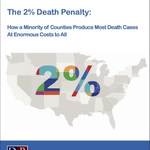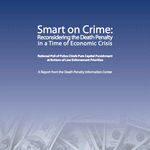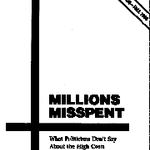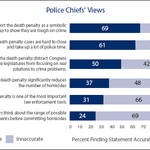
Costs
DPI Reports on Costs

The 2% Death Penalty: How a Minority of Counties Produce Most Death Cases at Enormous Costs to All (2013)
Contrary to the assumption that the death penalty is widely practiced across the country, it is actually the domain of a small percentage of U.S. counties in a handful of states. The burdens created by this narrow but aggressive use, however, are shifted to the majority of counties that almost never use it.
The disparate and highly clustered use of the death penalty raises serious questions of unequal and arbitrary application of the law. It also forces the jurisdictions that have resisted the death penalty for decades to pay for a costly legal process that is often marred with injustice.
Only 2% of the counties in the U.S. have been responsible for the majority of cases leading to executions since 1976. Likewise, only 2% of the counties are responsible for the majority of today’s death row population and recent death sentences. To put it another way, all of the state executions since the death penalty was reinstated stem from cases in just 15% of the counties in the U.S. All of the 3,125 inmates on death row as of January 1, 2013 came from just 20% of the counties.
Each decision to seek the death penalty is made by a single county district attorney, who is answerable only to the voters of that county. Nevertheless, all state taxpayers will have to bear the substantial financial costs of each death penalty case, and some of the costs will even be borne on a national level.
The counties that use the death penalty the most have some of the highest reversal rates and many have been responsible for errors of egregious injustice. As their cases are reversed, more money will be spent on retrials and further appeals. For example:
- Maricopa County in Arizona had four times the number of pending death penalty cases as Los Angeles or Houston on a per capita basis. The District Attorney responsible for this aggressive use was recently disbarred for misconduct.
- Philadelphia County, with the third largest number of inmates on death row in the country, ranked lowest in the state in paying attorneys representing those inmates.
- During the tenure of one district attorney in New Orleans, four death row inmates were exonerated and freed because of prosecutorial misconduct, bringing a stinging rebuke from four Justices of the U.S. Supreme Court.
Some states have recently chosen to opt out of this process altogether, greatly limiting their obligations for its high costs and disrepute. As the death penalty is seen more as the insistent campaign of a few at tremendous cost to the many, more states may follow that course.

Smart on Crime: Reconsidering the Death Penalty in a Time of Economic Crisis (2009)
The death penalty in the U.S. is an enormously expensive and wasteful program with no clear benefits. All of the studies on the cost of capital punishment conclude it is much more expensive than a system with life sentences as the maximum penalty. In a time of painful budget cutbacks, states are pouring money into a system that results in a declining number of death sentences and executions that are almost exclusively carried out in just one area of the country. As many states face further deficits, it is an appropriate time to consider whether maintaining the costly death penalty system is being smart on crime.
The nation’s police chiefs rank the death penalty last in their priorities for effective crime reduction. The officers do not believe the death penalty acts as a deterrent to murder, and they rate it as one of the most inefficient uses of taxpayer dollars in fighting crime. Criminologists concur that the death penalty does not effectively reduce the number of murders.
Around the country, death sentences have declined 60% since 2000 and executions have declined almost as much. Yet maintaining a system with 3,300 people on death row and supporting new prosecutions for death sentences that likely will never be carried out is becoming increasingly expensive and harder to justify. The money spent to preserve this failing system could be directed to effective programs that make society safer.

Millions Misspent: What Politicians Don’t Say About the High Costs of the Death Penalty (1994)
Across the country, police are being laid off, prisoners are being released early, the courts are clogged, and crime continues to rise. The economic recession has caused cutbacks in the backbone of the criminal justice system. In Florida, the budget crisis resulted in the early release of 3,000 prisoners. In Texas, prisoners are serving only 20% of their time and rearrests are common. Georgia is laying off 900 correctional personnel and New Jersey has had to dismiss 500 police officers. Yet these same states, and many others like them, are pouring millions of dollars into the death penalty with no resultant reduction in crime.
The exorbitant costs of capital punishment are actually making America less safe because badly needed financial and legal resources are being diverted from effective crime fighting strategies. Before the Los Angeles riots, for example, California had little money for innovations like community policing, but was managing to spend an extra $90 million per year on capital punishment. Texas, with over 300 people on death row, is spending an estimated $2.3 million per case, but its murder rate remains one of the highest in the country.
The death penalty is escaping the decisive cost-benefit analysis to which every other program is being put in times of austerity. Rather than being posed as a single, but costly, alternative in a spectrum of approaches to crime, the death penalty operates at the extremes of political rhetoric. Candidates use the death penalty as a facile solution to crime which allows them to distinguish themselves by the toughness of their position rather than its effectiveness.
The death penalty is much more expensive than its closest alternative – life imprisonment with no parole. Capital trials are longer and more expensive at every step than other murder trials. Pre-trial motions, expert witness investigations, jury selection, and the necessity for two trials – one on guilt and one on sentencing – make capital cases extremely costly, even before the appeals process begins. Guilty pleas are almost unheard of when the punishment is death. In addition, many of these trials result in a life sentence rather than the death penalty, so the state pays the cost of life imprisonment on top of the expensive trial.
The high price of the death penalty is often most keenly felt in those counties responsible for both the prosecution and defense of capital defendants. A single trial can mean near bankruptcy, tax increases, and the laying off of vital personnel. Trials costing a small county $100,000 from unbudgeted funds are common and some officials have even gone to jail in resisting payment.
Nevertheless, politicians from prosecutors to presidents choose symbol over substance in their support of the death penalty. Campaign rhetoric becomes legislative policy with no analysis of whether the expense will produce any good for the people. The death penalty, in short, has been given a free ride. The expansion of the death penalty in America is on a collision course with a shrinking budget for crime prevention. It is time for politicians and the public to give this costly punishment a hard look.
